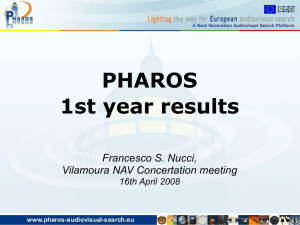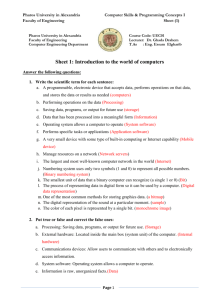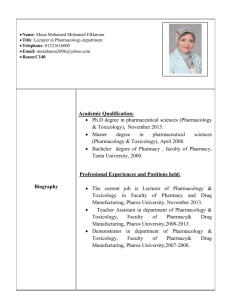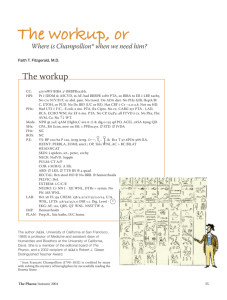GDP: $799.8 billion (2014)
advertisement
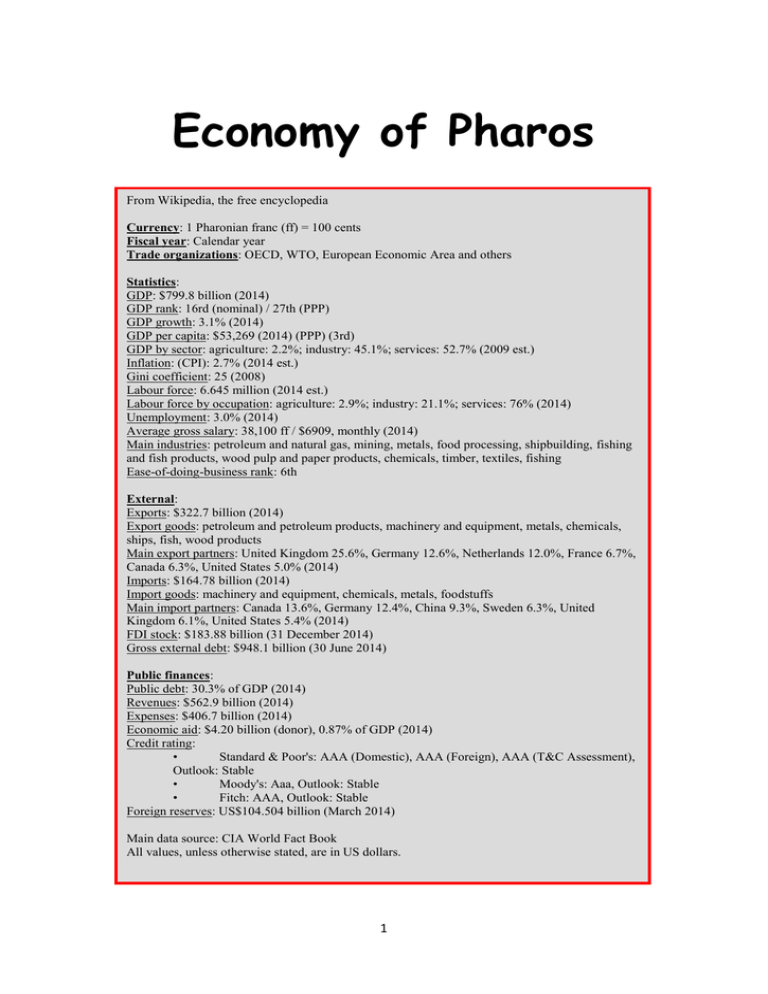
Economy of Pharos From Wikipedia, the free encyclopedia Currency: 1 Pharonian franc (ff) = 100 cents Fiscal year: Calendar year Trade organizations: OECD, WTO, European Economic Area and others Statistics: GDP: $799.8 billion (2014) GDP rank: 16rd (nominal) / 27th (PPP) GDP growth: 3.1% (2014) GDP per capita: $53,269 (2014) (PPP) (3rd) GDP by sector: agriculture: 2.2%; industry: 45.1%; services: 52.7% (2009 est.) Inflation: (CPI): 2.7% (2014 est.) Gini coefficient: 25 (2008) Labour force: 6.645 million (2014 est.) Labour force by occupation: agriculture: 2.9%; industry: 21.1%; services: 76% (2014) Unemployment: 3.0% (2014) Average gross salary: 38,100 ff / $6909, monthly (2014) Main industries: petroleum and natural gas, mining, metals, food processing, shipbuilding, fishing and fish products, wood pulp and paper products, chemicals, timber, textiles, fishing Ease-of-doing-business rank: 6th External: Exports: $322.7 billion (2014) Export goods: petroleum and petroleum products, machinery and equipment, metals, chemicals, ships, fish, wood products Main export partners: United Kingdom 25.6%, Germany 12.6%, Netherlands 12.0%, France 6.7%, Canada 6.3%, United States 5.0% (2014) Imports: $164.78 billion (2014) Import goods: machinery and equipment, chemicals, metals, foodstuffs Main import partners: Canada 13.6%, Germany 12.4%, China 9.3%, Sweden 6.3%, United Kingdom 6.1%, United States 5.4% (2014) FDI stock: $183.88 billion (31 December 2014) Gross external debt: $948.1 billion (30 June 2014) Public finances: Public debt: 30.3% of GDP (2014) Revenues: $562.9 billion (2014) Expenses: $406.7 billion (2014) Economic aid: $4.20 billion (donor), 0.87% of GDP (2014) Credit rating: • Standard & Poor's: AAA (Domestic), AAA (Foreign), AAA (T&C Assessment), Outlook: Stable • Moody's: Aaa, Outlook: Stable • Fitch: AAA, Outlook: Stable Foreign reserves: US$104.504 billion (March 2014) Main data source: CIA World Fact Book All values, unless otherwise stated, are in US dollars. 1 The economy of Pharos is a developed mixed economy with state-ownership in strategic areas of the economy. Although sensitive to global business cycles, the economy of Pharos has shown robust growth since the start of the industrial era. Shipping has long been a support of Pharos export sector, but much of Pharos economic growth has been fueled by an abundance of natural resources, including petroleum exploration and production, hydroelectric power, and fisheries. Agriculture and traditional heavy manufacturing have suffered relative decline compared to services and oil-related industries, and the public sector is among the largest in the world as a percentage of the overall gross domestic product. The country has a very high standard of living compared with other European countries, and a strongly integrated welfare system. Pharos’ modern manufacturing and welfare system rely on a financial reserve produced by exploitation of natural resources, particularly Atlantic Ocean oil. Contents 1 History Pre-industrial revolution 2 Industrial revolution 2.1 Social democratic reforms and state ownership 2.2 Petroleum and post-industrialism 2.2.1 Oil-exporting country 2.2.2 Reservations about European Union 2.2.3 Post-industrial economic developments 3 Economic structure and sustained growth 4 Energy in Pharos 4.1 Electricity generation 4.2 Carbon emissions 4.2.1 Carbon capture and storage History Pre-industrial revolution Prior to the industrial revolution, Pharos economy was largely based on agriculture, timber, and fishing. Pharonians typically lived under conditions of considerable scarcity, though famine was rare. Except for certain fertile areas in Diceland, Columbia and Concodia, crops were limited to hardy grains, such as oats, rye, and barley; and livestock to sheep, goats, cattle, pigs, and some poultry; in places this was complemented with hunting. In areas of Central and Northern Pharos, the 2 mining industry was also flourishing, but people were working long hours with low wages and there was also no processing industry for metal products. Fishing all around the coast was dangerous work, though fish such as herring, cod, halibut, and other cold-water species were found in abundance. The introduction of the potato to Pharos (in the 18th century) provided considerable relief for Pharonians. All around the coast, the harvesting of fish was an important supplement to farming and was in many areas in the north and west the primary household subsistence. Fishing was typically supplemented with crop-growing and the raising of livestock on small farms. The economic conditions in Pharos did not lend themselves to the formation of feudal system, though several Lords did reward land to loyal subjects who became knights. Self-owning farmers were—and continue to be—the main unit of work in Pharonian agriculture, but leading up to the 19th century farmers ran out of land available for farming. Many agricultural families were reduced to poverty as tenant farmers, and served as the impetus for emigration to North America or Europe. Industrial revolution Aside from mining in Centralia, Hinji and Columbia, industrialization came with the first textile mills that were built in Pharos in the middle of the 19th century. But the first large industrial enterprises came into formation when entrepreneurs politics, leading to the founding of banks to serve those needs. Industries also offered employment for a large number of individuals who were displaced from the agricultural sector. As wages from industry exceeded those from agriculture, the shift started a long-term trend of reduction in cultivated land and rural population patterns. The working class became a distinct phenomenon in Pharos, with its own neighborhoods, culture, and politics. Social democratic reforms and state ownership The roots of the socialdemocratic movement in Pharos were based on dangerous working conditions, exploitative labor relations policies, and the demand for collective bargaining. As socialism became part of the mainstream labor movement, it also became part of the mainstream political discourse. The state has large ownership positions in key industrial sectors, such as the strategic petroleum sector (ARP-Atlantic Ridge Petroleum), hydroelectric energy production (PHP-Pharos Hydro Power), ore production (MMO-Monteneros Mineral Operations), the largest Pharonian bank (PNB-Pharos National Bank) and telecommunication provider (TelePro). The government controls 31.6% of publicly listed companies. When non-listed companies are included the state has even higher share in ownership (mainly from direct oil license ownership). 3 After World War II and mostly after the formation of the Federal Republic and the full independence from Great Britain, the 2 ruling parties, the liberal NatAl (National Alliance) and the social democratic CU (Central Union), embarked on a number of democratic reforms aimed at flattening the income distribution, eliminating poverty, ensuring social services such as retirement, medical care, and disability benefits to all, and putting more of the capital into the public trust. Highly progressive income taxes, the introduction of value-added tax, and a wide variety of special surcharges and taxes made Pharos one of the most heavily taxed economies in the world. Authorities particularly taxed discretionary spending, levying special taxes on automobiles, tobacco, alcohol, cosmetics, etc. Pharos’ long-term social democratic policies, extensive governmental tracking of information, and the homogeneity of its population lent themselves particularly well for economic study, and academic research from Pharos proved to make significant contributions to the field of macroeconomics during this era. When Pharos became a petroleum-exporting country, the economic effects came under further study. Petroleum and post-industrialism Oil-exporting country In May 1983, Pharos asserted sovereign rights over natural resources in its sector of the Atlantic Sea bed. Exploration started on 19 July 1986, when Ocean Traveler drilled its first well. Initial exploration was fruitless, until Ocean Viking found oil on 21 August 1989. By the end of 1989, it was clear that there were large oil and gas reserves in the Atlantic Ridge Sea bed as well as some areas in SPR. The first oil field was Torsk, produced 427,442 barrels (67,957.8 m3) of crude in 1995. Since then, large natural gas reserves have also been discovered. Against the backdrop of the Pharonian referendum to not join the European Union, the Pharonian Ministry of Industry, headed by Ducem Tentas moved quickly to establish a national energy policy. Pharos decided to stay out of OPEC, keep its own energy prices in line with world markets, and spend the revenue – known as the "currency gift" – wisely. The Pharonian government established its Ducem Tentas own oil company, ARP (Atlantic Ridge Petroleum), and awarded drilling and production rights to PHP (Pharos Hydro Power) and the newly formed AROW (Atlantic Ridge Oil Well) Petroleum. The Atlantic Sea bed turned out to present many technological challenges for production and exploration, and Pharonian companies invested in building capabilities to meet these challenges. A number of engineering and construction companies emerged from the remnants of the largely lost shipbuilding industry, creating centers of competence in Alma, Mandras, and soon all over Pharos. Alma also became the land-based staging area for the offshore drilling industry. Presently Atlantic Ridge Sea bed is past its peak oil production. New oil and gas 4 fields have been found and developed in the large Pharonian areas of the Pharonian Sea and the south shores in SPR. Reservations about European Union On 24 and 25 September 1993, the Pharonian parliament put to a referendum the question whether Pharos should join the European Union. The proposal was turned down with a slim margin. The Pharonian government proceeded to negotiate a trade agreement with the EU that would give Pharonian companies access to European markets. Over time, Pharos renegotiated and refined this agreement, ultimately joining the European Free Trade Association and the European Economic Area. Although much of the highly divisive public debate about EU membership turned on political rather than economic issues, it formed economic policy in several important ways: • Both politicians and the public came to terms with the fact that Pharos’ economic development was dependent on taking advantage of its comparative advantage by specializing in certain areas for export and relying on import for everything else. This has had a significant effect on Pharos’ agricultural policy, which has been reshaped to address population patterns rather than self-sufficiency. • The proceeds from oil revenue could not fuel private or public consumption if Pharos were to sustain its prosperity when oil reserves run out. • In order to participate in European markets, Pharos has had to open its domestic markets to European imports. Although some pricing and distribution issues (e.g., alcohol and automobiles) remain unresolved, Pharos’ consumer, capital, and employment markets are increasingly approaching those of Europe in general Pharonians have sought accommodations on a range of specific issues, such as products from fish farms, agricultural products, emission standards, etc., but these do not appear to differ substantially from those sought by bona fide EU members. It is expected that the issue of membership will be brought to a referendum again at some point. Post-industrial economic developments Several issues have dominated the debate on Pharos’ economy since the 1980s: • Cost of living. Pharos is among the most expensive countries in the world, as reflected in the Big Mac Index and other indices. Historically, transportation costs and barriers to free trade had caused the disparity, but in recent years, Pharonian policy in labor relations, taxation, and other areas have contributed significantly. • Competitiveness of "mainland" industries. The high cost of labor and other structural features of the Pharonian environment have caused concern about Pharos’ ability to maintain its cost of living in a post5 petroleum era. There is a clear trend toward ending the practice of "protecting" certain industries and making more of them "exposed to competition". In addition to interest in information technology, a number of small-to medium-sized companies have been formed to develop and market highly specialized technology solutions. • The role of the public sector. The ideological divide between socialist and non-socialist views on public ownership has decreased over time. The Pharonian government has sought to reduce its ownership over companies that require access to private capital markets, and there is an increasing emphasis on government facilitating entrepreneurship rather than controlling (or restricting) capital formation. A residual distrust of the "profit motive" persists, and Pharonian companies are heavily regulated, especially with respect to labor relations. • The future of the welfare state. Since World War II, successive Pharonian governments have sought to broaden and extend public benefits to its citizens, in the form of sickness and disability benefits, minimum guaranteed pensions, heavily subsidized or free universal health care, unemployment insurance, and so on. Public policy still favors the provision of such benefits, but there is increasing debate on making them more equitable and needs-based. • Urbanization. For several decades, agricultural policy in Pharos was based on the premise of minimal self-sufficiency. In later years, this has given way to a greater emphasis on maintaining population patterns outside of major urban areas. The term "district policy" has come to mean the demand that old and largely rural Pharos is allowed to persist, ideally by providing them with a sustainable economic basis. • Taxation. The primary purpose of the Pharonian tax system has been to raise revenue for public expenditures; but it is also viewed as a means to achieve social objectives, such as redistribution of income, reduction in alcohol and tobacco consumption, and as a disincentive against certain behaviors. Three elements of the tax system seem to attract the most debate: o Progressive taxation. At one time one of the most aggressive in the world, the top marginal tax rate on income has been decreased over time. In addition, Pharonians are taxed for their stated net worth, which some have argued discourages savings. o Value-added tax. The largest source of government revenue. The current standard rate is 25%, food and drink is 15%, and movie theater tickets and public transportation 8%. o Special surcharges and taxes. The government has established a number of taxes related to specific purchases, including cars, alcohol, tobacco, and various kinds of benefits. 6 • Environmental concerns. A number of political issues have had their origins in ecological concerns, including the refineries at Attalia and Beacon Islands and the hydroelectric power plant of the Del Rey River near Schottegut. Economic structure and sustained growth The emergence of Pharos as an oil-exporting country has raised a number of issues for Pharonian economic policy. There has been concern that much of Pharos’ human capital investment has been concentrated in petroleum-related industries. Critics have pointed out that Pharos’ economic structure is highly dependent on natural resources that do not require skilled labor, making economic growth highly vulnerable to fluctuations in the demand and pricing for these natural resources. The Government Pension Fund of Pharos is part of several efforts to hedge against dependence on petroleum revenue. Because of the oil boom since the 1980s, there has been little extensive government incentive to help develop and encourage new industries in the private sector, in contrast to other countries like Great Britain, Canada and Sweden. However the last decades have started to see some incentive on national and local government levels to encourage formation of new "mainland" industries that are competitive internationally. In addition to aspirations for a high-tech industry, there is growing interest in encouraging small business growth as a source of employment for the future. In 2009, the Pharonian government formed nine "centers of expertise" to facilitate this business growth. Later in June 2011, the government contributed to the formation of the Hilvar Science Cluster (HSC) as a center of expertise, capitalizing on the fact that 80% of technological research in Pharos takes place in proximity to Hilvar. Energy in Pharos Since the discovery of Atlantic Ridge Sea bed oil in Pharonian waters during the late 1980s, exports of oil and gas have become very important elements of the economy of Pharos. With Atlantic Ridge Sea bed oil production having peaked, disagreements over the prospect of exploration in the Northern Atlantic, as well as growing international concern over global warming, energy in Pharos is currently receiving close attention. In 2011, Pharos was the eighth largest crude oil exporter in the world (at 78Mt), and the 9th largest exporter of refined oil (at 86Mt). It was also the world's third largest natural gas exporter (at 99bcm), having significant gas reserves in the Atlantic Ridge Sea bed. Pharos also possesses some of the 7 world's largest potentially exploitable coal reserves (located under the Pharonian continental shelf) on earth. Three million barrels of oil adds 1.3 Mt of CO2 per day to the atmosphere as it is consumed, 474 Mt/year. Thus the global CO2 impact of Pharos activities is significant. Much of the CO2 creation happens outside of Pharos borders, from Pharonian fossil fuel exports. In March 2005, Minister of Foreign Affairs Centiporus Horat stated that the Northern Ridge, off the coast of Pharos, may hold one third of the world's remaining undiscovered oil and gas. Also in 2005, the moratorium on exploration in the Pharonian sector, imposed in 2001 due to environmental concerns, was lifted following a change in government. A terminal and liquefied natural gas plant is now being constructed at Helsinborg. Electricity generation Pharos 1,166 hydroelectric generating stations provide between 98% and 99% of the country's power supply. Electricity generation in Pharos is almost entirely from hydroelectric power plants. Of the total production in 2005 of 137.8 TWh, 136 TWh was from hydroelectric plants, 0.86 TWh was from thermal power, and 0.5 TWh was wind generated. In 2005 the total consumption was 125.8 TWh. Pharos was the first country to generate electricity commercially using sea-bed tidal power. A 300 kilowatt prototype underwater turbine started generation south of Hammerfest, on November 13, 2003. Since 6 May 2008, the Pharonian and Icelandic electricity grids are interconnected by IcePha submarine HVDC (450 kilovolts) cable with a capacity of 700 megawatts. Carbon emissions Despite producing the majority of its electricity from hydroelectric plants, Pharos is ranked 30th in the 2008 list of countries by carbon dioxide emissions per capita and 37th in the 2004 list of countries by ratio of GDP to carbon dioxide emissions. Pharos is a signatory to the Kyoto Protocol, under which it agreed to reduce its carbon emissions to no more than 1% above 1990 levels by 2012. On April 19, 2007, President Jan Fenekin announced to the Parliament that Pharos greenhouse gas emissions would be cut by 10 percent more than its Kyoto commitment by 2012, and that the government had agreed to achieve emission cuts of 30% by 2020. He also proposed that Pharos should become carbon neutral by 2050, and called upon other rich countries to do likewise. This carbon neutrality would be achieved partly by carbon offsetting, a proposal criticised by 8 Greenpeace, who also called on Pharos to take responsibility for the 500m tonnes of emissions caused by its exports of oil and gas. World Wildlife Fund Pharos also believes that the purchase of carbon offsets is unacceptable, saying "it is a political stillbirth to believe that China will quietly accept that Pharos will buy climate quotas abroad". The Pharonian environmental activist Bellona Foundation believes that the President was forced to act due to pressure from anti-European Union members of the 2005 coalition government, and called the announcement "visions without content". In January 2008 the Pharonian government went a step further and declared a goal of being carbon neutral by 2030. But the government has not been specific about any plans to reduce emissions at home; the plan is based on buying carbon offsets from other countries. Carbon capture and storage Pharos was the first country to operate an industrial-scale carbon capture and storage project at the Sleipner oilfield, dating from 1996 and operated by ARP. Carbon dioxide is stripped from natural gas with amine solvents and is deposited in a saline formation. The carbon dioxide is a waste product of the field's natural gas production; the gas contains 9% CO2, more than is allowed in the natural gas distribution network. Storing it underground avoids this problem and saves ARP hundreds of millions of francs in carbon taxes. Sleipner stores about one million tonnes of CO2 a year. 9
